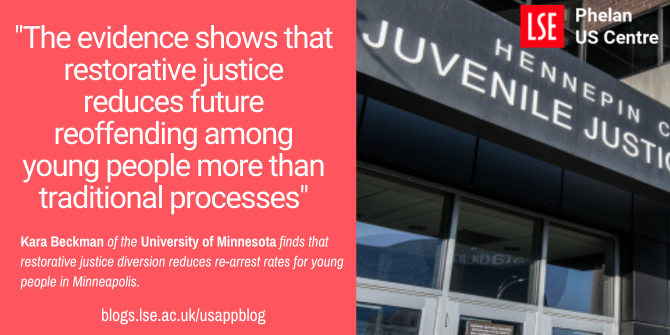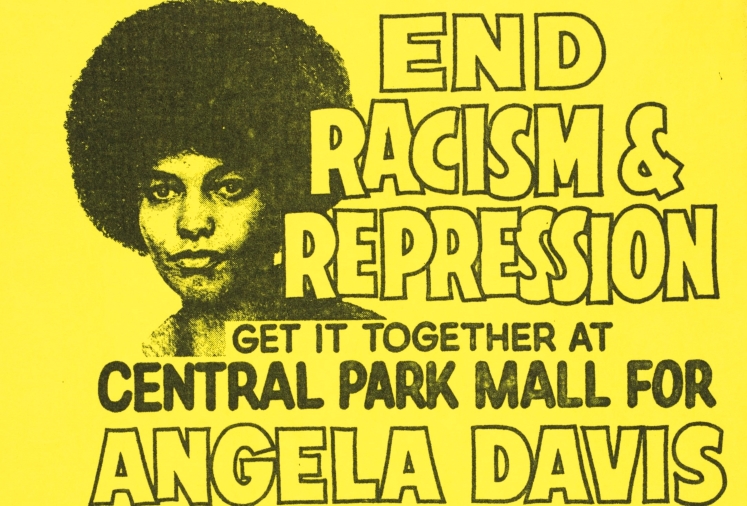 Young people who become involved in the criminal justice system often face lifelong consequences for their future health, employment, and education prospects. An alternative to this for young people is diversion. Kara Beckman looks at a Minneapolis diversion program which utilizes restorative justice processes and finds that both successful and unsuccessful diversion led to fewer repeat contacts with law enforcement for young people, compared to those who were never offered diversion. Considering these findings, she writes that restorative justice diversion programs should consider extending diversion eligibility to more youth.
Young people who become involved in the criminal justice system often face lifelong consequences for their future health, employment, and education prospects. An alternative to this for young people is diversion. Kara Beckman looks at a Minneapolis diversion program which utilizes restorative justice processes and finds that both successful and unsuccessful diversion led to fewer repeat contacts with law enforcement for young people, compared to those who were never offered diversion. Considering these findings, she writes that restorative justice diversion programs should consider extending diversion eligibility to more youth.
Children and youth who are arrested or cited by law enforcement and referred to the traditional legal system face a system that is difficult to navigate, given their developmental stage. Youth are asked to understand advice from lawyers, appear in court multiple times, comprehend contradictory messages (e.g., “take responsibility for your behavior” vs “anything you say can and will be used against you”), and comply with decisions imposed on them regarding their guilt, consequences, and conditions of accountability. Yet, the processes that are most likely to lead to healing and growth may never actually be required. Youth are rarely required to learn about or reckon with the impact of their behavior on other people, leaving victims frequently feeling unheard and unhealed. Youth who are charged often face long-lasting consequences for their future employment, health, and education prospects. These problematic results are magnified for youth of color, who are treated more severely than white counterparts.
This traditional process can make it more likely for a young person to become involved with the criminal justice system again, with one study showing law enforcement contact during adolescence made a young person three times more likely to be arrested as a young adult. Youth who are referred to the legal system do better when they are initially diverted out and have increasingly worse outcomes the deeper their involvement goes into the system.
It is clear we need better responses to harmful youth behavior that support youth on their journey to becoming caring, emotionally mature adults who are willing to take responsibility for their behavior. Diversion is the broad name for alternatives to the traditional court-centered processes of the criminal legal system. As a specific approach to diversion, restorative justice diversion engages the youth and their family, people harmed and their supporters, and skilled facilitators in a comprehensive dialogue to address and understand the impacts of their behavior. The dialogue culminates in the creation of an accountability plan that includes actions to meet the needs of people who were harmed or adversely impacted, and to prevent additional harm by addressing any underlying causes of the behavior.
Restorative justice aids adolescent development
Restorative justice may be ideal for young people because it requires their active engagement in processes that strengthen the social emotional skills essential to adolescent development: empathy, perspective taking, understanding and taking responsibility for how their thoughts and feelings impact their actions, and being accountable to the people they hurt with their behavior. Rather than removing family and community from the accountability process, restorative justice provides additional structure and support to them as the people best positioned to hold youth accountable and help address underlying issues. The process affirms a youth’s emerging self-image, rather than applying pejorative labels.
Increasingly, the evidence shows that restorative justice reduces future reoffending among young people more than traditional processes, whether it occurs in schools, is based on police referrals, in community-based settings with multiple referral sources, or as an alternative to prosecution or probation. However, there have been few studies which demonstrate whether restorative justice diversion is effective when police refer youth directly to community providers, and with diverse populations.

“Hennepin County Juvenile Justice Center,” (CC BY 2.0) by Tony Webster
Police-initiated, community-led restorative justice diversion
In new research, we examined the work and impact of the Minneapolis Juvenile Restorative Justice Collaborative (MJRJC.) The MJRJC is a group of local non-profits and system partners, including the Minneapolis Police Department, who coordinate a restorative justice diversion program. We looked at one year of additional arrest data for all misdemeanor cases in Minneapolis between September 2014 and December 2018, finding that repeat law enforcement contact was more frequent when diversion was never offered (36 percent) or when cases were unsuccessfully diverted (23 percent), compared with cases that were successfully diverted (15 percent). These differences remained significant after adjusting for factors such as race, age, sex, type of case and number of prior misdemeanor arrests. When comparing diversion outcomes between different racial groups, we found that in all meaningful racial groupings (i.e., excluding “other”), repeat contact with law enforcement was consistently lowest when cases went through diversion successfully (Figure 1). Even unsuccessful diversion – meaning young people were eventually referred to the court system – was typically followed by fewer repeat contacts with law enforcement compared with no diversion at all, at least among Black and American Indian individuals.
Figure 1 – Repeat arrest or citation by race and by justice approach taken

Notes: N=1,707 misdemeanor cases for 11-17 year olds, Minneapolis police department, 2014-2018
We also found differences in the success rates of diversion between the participating restorative justice agencies, which appeared to be driven by differences in ability to initially engage youth, not in the type of restorative justice process used.
Expanding restorative justice to more young people and communities
Our findings add to a growing body of literature which indicates that restorative justice with young people improves safety more than traditional legal system approaches. Communities, law enforcement agencies, youth leaders and advocates, and restorative justice practitioners can draw from this evidence to design a more effective response to young people who cause harm.
Where police departments are not connected to their local restorative justice community, they should initiate such relationships. While broader approaches are needed, law enforcement referring youth directly to community-led restorative justice diversion could positively impact perceptions of police trustworthiness.
Young people and their allies can aim to ensure that restorative justice providers, policy makers, and law enforcement incorporate the science of adolescent development into their decision-making and practice. Such advocacy can include not only that restorative justice diversion reduces recidivism and long-term negative life outcomes, but also that it creates an opportunity to uncover adverse circumstances and promote protective factors in the lives of adolescents.
Community-based restorative justice providers can take note of findings to continuously improve their practice. For example, positive impact regardless of whether agencies used circles, community conferencing, or family group conferencing aligns with scholarship suggesting restorative justice should be evaluated on its adherence to restorative principles, not specific practices used.
How agencies work matters for the effectiveness of diversion
In terms of observed differences in success rates between the agencies, variations in how they work may illuminate factors that hamper or foster engagement in diversion. First, across all agencies, the most common reason for unsuccessful diversion was loss of or no contact, with fewer instances of refusal or not completing the accountability plan. Two of three agencies who engage volunteers had higher rates of no contact, suggesting the possibility that variation in how agencies engage community members, staff, and volunteers matters. Conversely, the three agencies with the highest success rates all specialized in populations, whether demographic, neighborhood, or school based. Other factors which may also have influenced engagement rates were language barriers among the population served, the case volume in each agency, agency experience, and the complexity of cases.
Expanding diversion and restorative justice
We recommend restorative justice diversion programs consider extending diversion eligibility to more youth, by making a broader range of offenses and offense histories eligible for diversion. For example, in Minneapolis, youth who had previously been adjudicated for a felony offense are not currently eligible for diversion. We also encourage additional research to look at whether and under what conditions restorative justice diversion can foster sustained beneficial individual and societal outcomes, including young people’s long-term successes and positive contributions to society.
- This article is based on the paper, ‘Reducing Re-arrest Through Community-Led, Police-Initiated Restorative Justice Diversion Tailored for Youth’ in Crime & Delinquency
- Please read our comments policy before commenting.
- Note: This article gives the views of the author, and not the position of USAPP – American Politics and Policy, nor the London School of Economics.
- Shortened URL for this post: https://bit.ly/3Of7sqW






